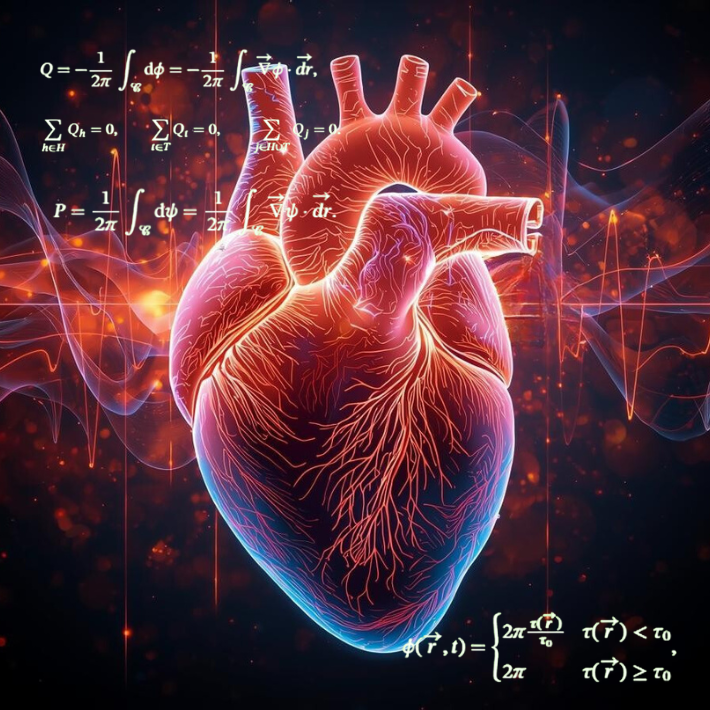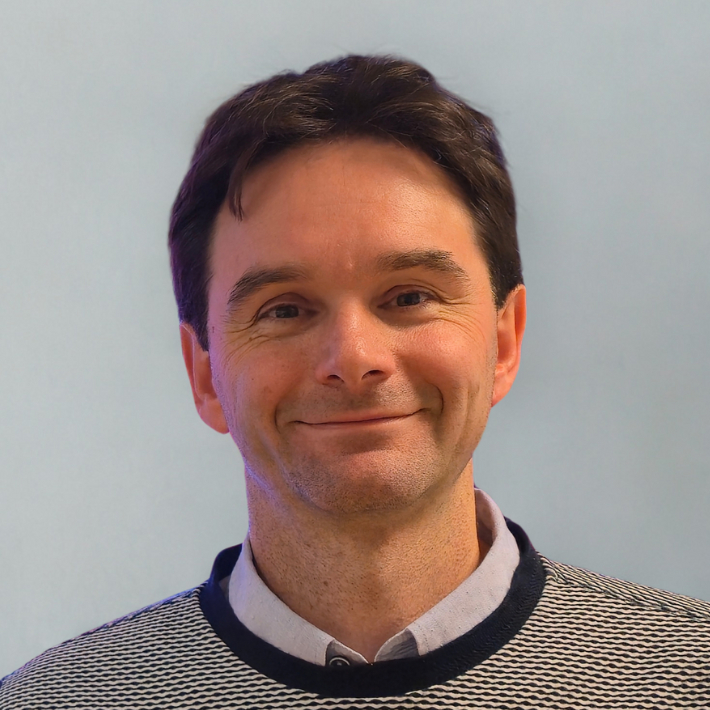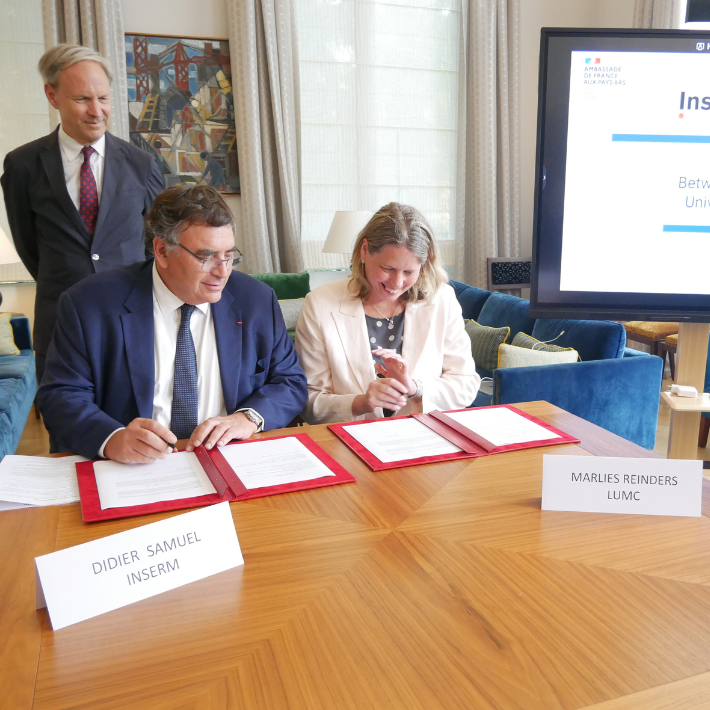Mathematics as the heart's interpreter
Mathematics as the heart's interpreter. This image has been generated with artificial intelligence.
&width=710&height=710)
Within the Laboratory for Experimental Cardiology at the Department of Cardiology, physics and mathematics are used to better understand and treat cardiac arrhythmias. We spoke with associate professor Hans Dierckx about this multidisciplinary approach.
The “Wave”
The heart functions through a continuous stream of electrical impulses. These impulses cause the heart to contract and relax, ensuring proper blood circulation. They originate in the sinus node, a natural pacemaker located at the top of the heart. From there, the impulse spreads like a wave through the heart.
Dierckx (see picture) compares this process to a wave in a stadium: "In a wave, one group of people stands up first, then the next, and so it goes like a wave through the stadium. Everyone reacts to what is happening right in front of them. The heart works similarly. In a healthy heart, the sinus node regularly emits an electrical impulse. The impulse moves like a wave through the heart: first through the atria and then through the ventricles. This causes them to contract in the right order and the blood to flow in the right direction."
Cardiac arrhythmias
If the heart is damaged or not functioning properly, an electrical impulse may arrive too early, too late, or in the wrong place. This disrupts the wave. Instead of moving smoothly through the heart, spiral waves form and keep rotating, disturbing the normal rhythm. The heart may beat too fast, too slow, or irregularly. This is called a cardiac arrhythmia.
“Think of a breakwater,” says Dierckx. “When a wave hits it, the wave changes direction or stops. And whirlpools are created. Something similar happens in the heart. There are places in the heart tissue where the electrical wave cannot go any further. These places are called conduction blocks. When a wave hits them, the wave can extinguish, change direction, or start spinning and cause an arrhythmia.”
Certain cardiac arrhythmias can be corrected with a treatment called ablation. First, the cardiologist locates the area in the heart where the wave is disrupted. This is done during a procedure called an electrophysiological study (EPS). Once identified, the area is treated with heat or cold using an electrode inserted into the heart via a catheter. The treatment disables the problematic tissue, preventing it from sending incorrect electrical impulses and restoring normal rhythm.
Mathematics as a listening ear
It is difficult to see exactly what happens in the heart during an arrhythmia. “We measure electrical signals on the outside of the heart wall to determine where the ablation should take place,” says Dierckx. But we cannot say with certainty what is happening inside the heart. It's like trying to eavesdrop on a conversation by putting your ear to the wall. You can hear something, but it's muffled and vague."
To gain better insight, Dierckx develops mathematical computer models that visualize the heart’s electrical activity. In 2024, he received a LUMC Fellowship for this work. He uses data from heart tissue and patient measurements to predict how cardiac arrhythmias develop and evolve.
“With our mathematical models, we convert those muffled voices into a clear conversation,” he explains. “This is how we discovered that there can be different types of conduction blocks in the heart wall and also which types do not occur.”
The roundabout
Mathematical models not only provide insight into where things go wrong, but also into how electrical waves move through the heart. This turns out to be more complex than previously thought. So complicated, in fact, that according to Dierckx, “no one could make head nor tail of it before.” In a recent publication in the scientific journal Physical Review Letters, Dierckx and his colleagues change this by literally describing the ‘head’ and ‘tail’ of the electrical wave mathematically.
“Previously, scientists believed that arrhythmias originated at a single point, but we have demonstrated that conduction blocks can also be complex surfaces that the electrical wave encounters. Some of these surfaces are so large that the electrical wave simply cannot pass through them and must go around them.”
Dierckx explains: “These impenetrable surfaces are like traffic jams on a roundabout. Successive electrical waves are like groups of cars entering the roundabout at short intervals. Normally, the road is clear, but a conduction block causes a traffic jam. The last cars in the previous wave (= tail) cannot exit the roundabout in time. Two things can happen: the ‘head’ of the next wave collides with the ‘tail’ of the previous one, or it swerves and detours around the roundabout via the shoulder.”
Just as you can observe traffic flow or congestion by watching cars on a roundabout, researchers use mathematical models to pinpoint where things go wrong in the heart. They even discovered new, compound roundabouts that may explain certain complex wave patterns.
Towards a digital twin
To better understand these complex wave movements, the researchers are building a digital twin of the heart. This is a virtual copy of a real heart, based on a patient's medical data. Dierckx: "You can think of it as a test heart on the computer. We put as much data into it as possible, such as the shape of the heart, the direction of the muscle fibers, and how it responds electrically. This allows us to simulate what happens during a cardiac arrhythmia without affecting the real body."
Thanks to the digital twin, researchers can experiment safely. For example, they can test what happens when an electrical wave collides with a conduction block, or how a treatment affects the rhythm. Dierckx: “It helps us predict where a rhythm disorder will occur and how best to stop it. We can also use the digital model to test how new drugs work on conduction blockages.”
Future
“In the future, I hope that we will be able to use our mathematical models and the digital twin during ablation procedures,” says Dierckx. “This will enable us to provide the cardiologist with real-time information about what is happening in the heart during treatment.”
To make this possible, Dierckx collaborates closely with the Faculty of Mathematics and Natural Sciences. He aims to strengthen this partnership so that more insights and techniques from math and physics find their way into medical applications. “This way, we contribute to better healthcare for tomorrow.”
Because the model is tailored to the patient, personalized treatment becomes possible. The cardiologist can treat more precisely, making ablation potentially more accurate and less invasive. In this way, the researchers hope to be able to treat cardiac arrhythmias even more personally and effectively in the future.

&width=710&height=710)
&width=710&height=710)